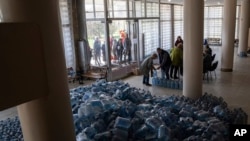In the lead up to the first anniversary of Russia’s invasion of Ukraine on February 24, United Nations aid agencies have been stepping up lifesaving relief to thousands of people living in conflict “hot spots.”
Two inter-agency convoys reached communities in acute need on the front lines this past week. A six-truck convoy arrived in the eastern Ukrainian town of Toretsk, about 10 kilometers from the combat zone in the Donetsk region, last Tuesday.
Jens Laerke, a spokesman for the U.N. Office for the Coordination of Humanitarian Affairs, OCHA, said the convoy carried essential relief, including water, medicine, and emergency shelter materials.
“The convoy also delivered trauma and emergency surgery kit supplies,” he said. “Approximately 15,000 people of the 75,000 residents who lived there before the war are still in that town and nearby communities.”
Pro-Russian separatists briefly seized Toretsk after the war between the Russian-backed rebels and Ukrainian government broke out in the Donbas region in 2014. While Ukrainian forces retook Toretsk later that year, the town has been in the line of fire since then and has had its critical water supply cut multiple times.
On Thursday, a second five-truck inter-agency convoy reached the town of Huliaipole in the Zaporizhzhia region, where some 3,000 people remain close to the contact line and are exposed to regular shelling.
Laerke said access to basic services has been disrupted, causing enormous hardship for the vulnerable residents, particularly the elderly, people with disabilities, and families with children.
“Since March last year, the residents have had no electricity as the facilities were damaged by fighting and cannot be repaired due to ongoing hostilities,” he said.
“Because there is no power, water facilities cannot operate, and water has to be delivered in bottles or pumped from the wells.”
Marco Rotelli, OCHA deputy humanitarian coordinator, supervised the unloading of relief supplies in Huliaipole. He said U.N. agencies and non-governmental agencies were urgently working to repair damaged homes to protect people against the savage winter.
“This is very important because of the harsh conditions and due to the shelling and mass destruction.”
He said, “The temperature is below zero, the conditions are very harsh, and this intervention is very timely because we could not come here for quite a long time because of the ongoing hostilities.”
Russian forces have intensified fighting in the region in recent weeks, in what is seen as a departure from what has been a months-long frozen conflict.
Oleksii Reznikov, Ukraine’s defense minister, told French media Wednesday that he believed Russia was planning a major offensive to mark the first anniversary of the war and could be massing as many as half a million troops at the border.
“We do not underestimate our enemy. Officially they announced 300,000 [conscripted soldiers], but when we see the troops at the borders, according to our assessments it is much more,” he said.
OCHA spokesman Laerke said his agency was constantly monitoring the situation in Ukraine and preparing for the future, but the primary focus for now was on providing support for people currently in need.
“Focus is really now shifting to reaching as many people as we can as close to the frontline as we can.
“What is happening right now in Ukraine is we are seeing more and more of these inter-agency convoys pushing closer to the front lines, delivering to people in dire need,” he said.
He said that convoy planning is a constant process conditioned by security on the ground and that current and future relief convoys could be forced to turn back if fighting on the ground escalates.
Laerke said OCHA notifies parties to the conflict about impending convoys and reminds them of their international obligations to help the convoys reach their destinations safely.
He noted that more than 30 inter-agency convoys have delivered humanitarian supplies to vulnerable communities in Ukraine’s eastern oblasts in the last 11 months and that none has been attacked.
Separately, he said several notifications have gone out to reach areas under the current control of the military of the Russian Federation.
But up until today, he said no U.N. relief convoys have been provided “in the sense that we have not been given the adequate assurances of security to go to these areas.”











